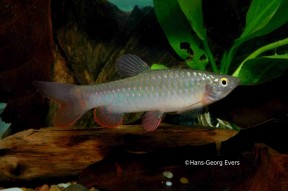Copeina guttata
Red-spotted Tetra
SynonymsTop ↑
Pyrrhulina guttata Steindachner, 1876; Pyrrhulina argyrops Cope, 1878
Etymology
guttata: from the Latin gutta, meaning ‘spots, specks’, in reference to this species’ spotted colour pattern.
Classification
Order: Characiformes Family: Lebiasinidae
Distribution
Known from the middle and upper Amazon river basins in Brazil, Peru, Ecuador and Colombia.
Type locality is ‘Amazon River at Obidos, Cudajas, and Tabatinga; Rio Negro, Brazil.’
Maximum Standard Length
The largest specimen known measured 76 mm.
Aquarium SizeTop ↑
Given its potential size an aquarium measuring 120 ∗ 30 cm or similar should be the smallest considered.
Maintenance
Choice of decor is not especially critical although it tends to show better colouration when maintained in a well-furnished set-up with live plants and a dark substrate.
A natural-looking arrangement might consist of a soft, sandy substrate with wood roots and branches placed such a way that plenty of shady spots are formed.
It seems to do best under relatively dim lighting and plant species from genera such as Microsorum, Taxiphyllum, Cryptocoryne or Anubias are recommended since they will grow under such conditions, and a few patches of floating vegetation may also prove effective.
Like many fishes that naturally inhabit pristine environments it’s intolerant to accumulation of organic pollutants and requires spotless water meaning weekly water changes should be considered routine, and it should never be introduced to a biologically immature tank.
Water Conditions
Temperature: 20 – 28 °C
pH: 4.0 – 7.5
Hardness: 18 – 179 ppm
Diet
Probably feeds on insects at or near the water surface in nature.
In the aquarium it’s easily-fed but the best condition and colours offer regular meals of small live and frozen foods such as bloodworm, Daphnia, and Artemia alongside good quality dried flakes and granules, at least some of which should include additional plant or algal content.
Sexual Dimorphism
Males are more intensely-coloured than females and tend to develop extended fins.
Reproduction
Apparently practises an interesting reproductive strategy in which the eggs are deposited in a shallow depression excavated from the substrate and guarded by the male.
NotesTop ↑
The family Lebiasinidae is included in the order Characiformes and sometimes split into the nominal subfamilies Lebiasininae and Pyrrhulininae, though there has not been a major review of the grouping in recent times.
All lebiasinid genera possess a relatively long, elongate body shape with 17-33 scales in the lateral series and laterosensory canal system absent or reduced to 7 scales or less.
Some species have an adipose fin while others do not, and the anal-fin has a relatively short base of 13 scales or less.
In the majority of members males have an enlarged or otherwise well-developed anal-fin used in courtship and spawning.
The frontal/parietal fontanelle is always absent, the cheek well-covered by the orbital and opercular bones, the supraoccipital crest is absent, and the scales of the dorsal body begin over the parietal bones.
Characiformes is among the most diverse orders of freshwater fishes currently including close to 2000 valid species distributed among 19 families.
This tremendous taxonomical and morphological diversity has historically impaired the ability of researchers to resolve their genetic relationships with many genera remaining incertae sedis.
A further limiting factor has been that in many cases exhaustive study of these on an individual basis is the only way to resolve such problems.
Modern molecular phylogenetic techniques have allowed some headway, though, and a research paper by Calcagnotto et al. published in 2005 revealed some interesting hypotheses.
Their results suggest that Lebiasinidae forms a trans-atlantic, monophyletic clade alongside the families Ctenoluciidae and Hepsetidae, this clade further forming a sister group to Alestidae.
Others such as Oliveira et al. (2011) have concluded that the family Erythrinidae is also closely-related to this grouping with Hepsetidae and Alestidae more distant.
References
- Steindachner, F., 1876 - Sitzungsberichte der Kaiserlichen Akademie der Wissenschaften. Mathematisch-Naturwissenschaftliche Classe v. 72 (1. Abth.): 6-24
Beiträge zur Kenntniss der Characinen des Amazonenstromes. - Ortega, H. and R. P. Vari , 1986 - Smithsonian Contributions to Zoology No. 437: iii + 1-25
Annotated checklist of the freshwater fishes of Peru. - Reis, R. E., S. O. Kullander and C. J. Ferraris, Jr. (eds), 2003 - EDIPUCRS, Porto Alegre: i-xi + 1-729
Check list of the freshwater fishes of South and Central America. CLOFFSCA.




